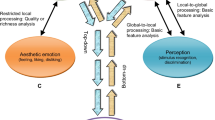Abstract
Experimental phenomenology has demonstrated that perception is much richer than stimulus. As is seen in color perception, one and the same stimulus provides more than several modes of appearance or perceptual dimensions. Similarly, there are various perceptual dimensions in form perception. Even a simple geometrical figure inducing visual illusion gives not only perceptual impressions of size, shape, slant, depth, and orientation, but also affective or aesthetic impressions. The present study reviews our experimental phenomenological work on visual illusion and experimental aesthetics, and examines how aesthetic preference is influenced by stimulus factors determining visual illusions including anomalous surface and transparency as well as geometrical illusion. Along with line figures producing geometrical illusions, illusory surface figures inducing neon color spreading and transparency effects were used as test patterns. Participants made both of psychophysical judgments and of aesthetic judgments for the same test pattern. Both of geometrical illusions and aesthetic preferences were found to change similarly as a function of stimulus variables such as the number of filling lines and the size ratio of the inner and outer figural components. Also, following specific stimulus variables such as lightness contrast ratio and spatial interval between inducing figural elements (so called ``packmen''), strong effects of color spreading and transparency were accompanied with strong preferences. It seems that the paradigm to investigate aesthetic phenomena along with perceptual dimensions is useful to bridge the gap between experimental phenomenology and experimental aesthetics.
Similar content being viewed by others
REFERENCES
Arnheim, R.: 1954, Art and Visual Perception-A Psychology of the Creative Eye, Berkeley and Los Angeles: University of California Press.
Berlyne, D.E.: 1974, 'The New Experimental Aesthetics', in D.E. Berlyne (ed.), Studies in the New Experimental Aesthetics, New York: John Wiley.
Birkhoff, G.D.: 1933, Aesthetic Measure, Cambridge, MA: MIT Press.
Coren, S. and J.S. Girgus: 1978, Seeing and Deceiving, Hillsdale, New Jersey: Lawrence Erlbaum.
Day, R.H., S. Bellamy and A. Norman: 1983, 'The Morinaga Misalignment Illusion', Journal of Experimental Psychology: Human Perception and Performance 9, 113–125.
Day, R.H. and R.T. Kasperczyk: 1984, 'The Morinaga Misalignment Effect with Circular Stimulus Elements', Bulletin of the Psychonomic Society 22, 193–196.
Day, R.H. and R.T. Kasperczyk: 1985, 'The Morinaga Misalignment Effect: Reduction and Reversal by Modification of Figural Extremities', Psychological Research 47, 95–101.
Helson, H.: 1951, 'Perception', in H. Helson (ed.), Theoretical Foundations of Psychology, New York: D. Van Nostrand.
Helson, H.: 1973, 'A Common Model for Affectivity and Perception: An Adaptation-Level Approach', in D.E. Berlyne and K.B. Madsen (eds.), Pleasure, Reward, and Preference, New York: Academic Press.
Hubel, D.H. and T.N. Wiesel: 1962, 'Receptive Field, Binocular Interaction and Functional Architecture in the Cat's Visual Cortex', Journal of Physiology (London) 160, 106–154.
Kandinsky, W.: 1926, Punkt und Linie zur Flaeche, Munich: Albert Langen Verlag.
Klee, P.: 1956, Das bilderische Denken, Basel: Schwabe, (Thinking Eye, New York: Wittenborn).
Klee, P.: 1970, Notebooks, Vol. 2, The Nature of Nature (translated from the German edition: Die unendliche Natur), Basel: Schwabe.
Marr, D. and E. Hildreth: 1980, 'Theory of Edge Detection', Proceedings of Royal Society, London B 207, 187–217.
Metzger, W.: 1954, Psychologie, Darmstadt: Verlag von Dr. Dietrich Steinkopff.
Mitsui, K. and K. Noguchi: 2002, 'Aesthetic Arrangement of Disks', Paper presented for 21st Annual Meeting of Japanese Psychonomic Science (In Japanese).
Morinaga, S.: 1935, 'Conditions for Size-Assimilation and Size-Contrast', in K. Hirose (ed.), Festschrifts in Honor of Dr. K. Masuda, Tokyo: Iwanami-Shoten (In Japanese), pp. 28–48.
Morinaga, S.: 1941, 'Beobachtingen über Grundlagen und Wirkungen anschaulich gleichmäßiger Breite', Archiev für gesamte Psychologie 110, 309–348.
Morinaga, S.: 1957, 'Uber die Raumwahrnehmung bei optischen Taeusxhungen', Proceedings of IV International Congress of Psychology, Brussels, Belgium.
Noguchi, K. and T. Fujii: 1999, 'Gestalt Factors in Geometrical Illusion: In Case of Botti Type Figure', Journal of Faculty of Engineering Chiba University 50, 35–37.
Noguchi, K. and H. Kuroda: 1984, 'Effects of Similarity Grouping on Geometrical Illusions', Abstract Guide of XXIII International Congress of Psychology, Acapulco, Mexico.
Noguchi, K., Y. Wada, D. Yoshino and I. Rentschler: 2002, 'Aesthetic Preference in Illusory Figures', Proceedings of 17th Congress of International Association of Empirical Aesthetics, pp. 117–120.
Ogasawara, J.: 1952, 'Displacement Effect of Concentric Circles', Japanese Journal of Psychology 22, 224–234.
Oyama, T.: 1962, 'The Effect of Hue and Brightness on the Size-Illusion of Concentric Circles', American Journal of Psychology 75, 45–55.
Rentschler, I., R. Hilz, C. Sütterlin and K. Noguchi: 1981, 'Illusions of Filled Lateral and Angular Extent-The Role of Cortical Feature Detectors', Experimental Brain Research 44, 154–158.
Restle, F.: 1976, 'Morinaga's Paradox and Figure-Ground Organization', Perception and Psychophysics 20, 153–156.
Robinson, J.O.: 1972, The Psychology of Visual Illusion, London: Hutchinson.
Sherrington, C.: 1963, Man on His Nature, Cambridge, UK: Cambridge University Press.
Takashima, M. and K. Noguchi: 2002, 'Aesthetic Preference in Color Assimilation and Contrast', Paper presented for 21st Annual Meeting of Japanese Psychonomic Science (In Japanese).
Rights and permissions
About this article
Cite this article
Noguchi, K. The Relationship Between Visual Illusion and Aesthetic Preference – an Attempt to Unify Experimental Phenomenology and Empirical Aesthetics. Axiomathes 13, 261–281 (2003). https://doi.org/10.1023/B:AXIO.0000007184.98668.bc
Issue Date:
DOI: https://doi.org/10.1023/B:AXIO.0000007184.98668.bc




